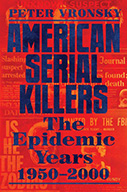American Serial Killers: The Epidemic Years 1950-2000

Author: Peter Vronsky
Publisher: New York: Berkley. 2020. 416p.
Reviewer: Katherine Ramsland | September 2021
Despite the recent high-profile arrests of serial killers like Sam Little and Joseph DeAngelo, their media attention was a mere echo of the buzz that made Ted Bundy and Jeffrey Dahmer into celebrities. Something about the 1970s and ‘80s, says crime historian Peter Vronsky, made serial murder into a spectacle. He offers a theory about social factors that spawned this “golden age,” but he focuses mostly on sexually compelled male offenders. Within this theme, American Serial Killers is a highly readable overview of extreme criminality. The book is a series of extended true crime tales that show how the sins of the fathers and the impact of stressful social conditions negatively influenced a generation of sons. Vronsky argues that, as these dynamics lost force, the numbers of serial killers and their victim totals have declined. Should such a “perfect storm” of factors occur again, there could be trouble ahead.
Vronsky singles out a “species” of serial killer in the United States, especially during the late twentieth century, when an estimated 83 percent of the total made their appearance. “In the past,” he writes, “a serial killer had been traditionally defined as someone who murders three or more victims in separate sexual fantasy-driven murders with a ‘cooling off’ period in between.” This claim is puzzling. No past criminological text has been recognized as a definitive authority on the concept of serial killers. The FBI’s approach comes the closest, yet even this has evolved.
The criteria for defining a serial killer began to form for law enforcement during the 1970s, with the FBI’s budding Behavioral Science Unit leading the way. These agents studied repeat multicidal killers for their teaching curriculum. They initially required three or more victims in three or more locations. These killings were considered separate but linked events, with a “cooling off” period between them. The requirement for three locations dropped out by 1992 in The Crime Classification Manual, which states: “Serial murders involve three or more separate events, with an emotional cooling off period between homicides.” There was no specific motive indicated.
Still, some criminologists argued that motivation helped to distinguish a specific type of offender from those that commit multiple murders, but that would not qualify as serial killers (e.g., those in gangs and organized crime syndicates). In addition, some thought the concept of a cooling off period was unclear. Pressed on these points, the FBI agreed.
To develop a more widely acceptable definition, in 2005 the agency organized a symposium for law enforcement personnel, academicians, and clinicians. Experts represented ten countries and five continents. According to one of the organizers, the participants agreed that the lowest possible minimum number of victims would offer the greatest flexibility for law enforcement and still be useful for research. Since serial killers had several different motivators (power, thrill, anger, profit, mission), it seemed expedient to leave motivation out. A small group of researchers proposed subsuming all motives under erotic excitement, but it didn’t stick. The FBI announced the final definition: The unlawful killing of two or more victims by the same offender(s), in separate events. Thus, Vronsky’s focus on male sexual serial killers works well for his species-specific theme, but it doesn’t necessarily work for other types that most criminologists would view as serial killers (e.g., Donald Harvey, Aileen Wuornos).
Vronsky’s perfect storm of factors needs the incubator of sexual fantasy. He identifies troublesome social trends that few theorists have considered. The making of a sexually motivated serial killer, it seems, is the result of a violent heritage passing from one generation to another, “each crippling its young, leaving behind, at best, a crop of abused and maladjusted individuals, or at worst, a series of raped and dead murder victims.” The Great Depression, World War II-era parental traumas, and the easy access of true-detective and men’s adventure “sweats” became “transgressive scripting” for domination fantasies. The social indulgences for psychologically wounded men would twist a generation of boys with the “repressively sick celebration of women’s abduction, rape, mutilation and murder.”
Ted Bundy discussed this subject in a pre-execution interview, but most experts dismiss his claim that pornography had so strongly affected him. Vronsky doesn’t. In fact, other serial killers have similarly described the impact during their boyhood of seeing bound, barely-clad, terrified women on the covers of true detective magazines. They spotted them on drugstore shelves, in barbershops, or in their father’s secret stash. The spicy images preoccupied them. Despite the fact that the majority of pornography consumers don’t become serial killers, the adverse influence on some cannot be ignored. These magazines, Vronsky says, offered “some kind of powerful primordial male reptilian euphoria” – a stirring of the need to control females who threaten to undermine their power. He sees the evidence in the proliferation of golden age, sexually compelled serial killers.
In contrast, during the first four decades of the twentieth century, around 200 serial killers were documented, albeit not by this label. Only a few are known because media outlets preferred to depict this carnage as foreign, not American. Vronsky describes such offenders as “often odd or twitchy, Scripture-quoting, rootless, migratory, shabby outsiders; sick refugee flagellant drifters with indiscernible specks of dried blood on the cuffs of their soiled shabby pants.” From 1960-1969, as the Boston Strangler and the Zodiac Killer rose to media prominence, they weren’t yet recognized as part of a “species.”
The discovery in California in 1971 of the mass graves of twenty-five migrant workers who Juan Corona murdered appears to have launched the “epidemic.” Then came Houston’s “Candy Man” murders with a higher victim toll. By 1973, Edmund Kemper had slaughtered six coeds among his eight victims in Santa Cruz, concurrent with spree killer Herbert Mullin’s psychotic mission that snuffed thirteen lives. The “Son of Sam” killings in New York, mid-decade, targeted girls and couples, and toward the end of the 1970s, Ted Bundy was caught. Yet B.T.K., the Hillside Strangler, the Dating Game Killer, and the Golden State Killer (to name a few) remained active. The media, now eager for profitable material, gave them all headlines, and the FBI formed its Behavioral Science Unit in response. The 1980s brought a higher surge, the most of any decade. But during the 1990s, the numbers fell.
To be clear, comparison methods across time periods should share similar forms of data recognition, collection and interpretation. With the diverse recording, methods of crime investigation and database development, it remains uncertain whether all relevant cases have been gathered for this study. For example, Sam Little’s alleged 93 victims would never have been attributed to a serial killer had he not confessed in 2018. Even now, they haven’t all been corroborated. Are there other killers like him? How many? Did any cases only speculatively linked to a serial killer end up in databases? (Ted Bundy’s claim of thirty or more gets recorded but has not been fully corroborated.) Add the lack of resources for media coverage during earlier periods and the fact that obscure past cases are still coming to light, and it’s difficult to tell if Vronsky’s claims hold up. He recognizes that the databases he cites include killers with other motives, which also affects his calculations.
Even with these potential challenges, Vronsky’s meticulous scholarship for case analysis is impressive. He writes with an accessible rhythm, offering history and sociology balanced with true-crime detail. For example, when he tells the story of William Heirens, it is a full account, including how it evolved since the “Lipstick Killer’s” 1940s confession into current efforts to exonerate him. Many other cases get similar comprehensive treatment. Vronsky has been in the crime reporting business for years, so his familiarity with this topic gives his narrative a compact fluidity. In places, the storytelling is exceptional, with descriptions that border on literary.
He also effectively demonstrates the media’s power over our concepts. How we think about serial killers depends largely on their depiction in news, novels, film, and TV shows. At first, men who killed multiple victims were shocking, launching extensive coverage. As this novelty wore off, especially when victims were from marginalized communities, media outlets focused mostly on those with a unique flair: the baker who hunted women in the wilderness, the serial killer cop, the gay cannibal. Vronsky describes Jeffrey Dahmer as the last “celebrity” from the epidemic generation. No serial killer following him garnered the kind of media attention that he received. The decline had begun. But there could yet be another convergence of fertile factors. With the financial crisis of 2008, the War on Terror, and the COVID-19 pandemic, Vronsky suggests, “we are looking into the abyss of a new American Noir like the one in the 1940s but worse.”
The author’s argument has merit, but there have certainly been serial killers post-1990s who attracted headlines. Charles Cullen, a healthcare serial killer, pled guilty to twenty-nine murders and six attempted murders in 2003, and he was the first (and only) serial killer to be given prominent exposure on 60 Minutes. Israel Keyes’ unique MO of burying random murder kits ahead of time drew plenty of attention. “Hollywood Ripper” Michael Gargiulo had some high-profile moments during his 2019 trial, and if the Long Island Serial Killer is ever identified, the media coverage will be significant.
This raises a potential factor that Vronsky does not cover. The reduced celebrity status for today’s serial killer might be linked to the lack of a sensational trial. Keyes killed himself in 2012, and other offenders struck plea deals. There has been no drama like Ted Bundy representing himself on a world stage, Dahmer’s televised insanity hearing, or the tension-filled wait for verdicts for John Wayne Gacy.
Far more boys exposed to the same potentially causative factors did not become serial killers, so there must be differences that sociology does not adequately explain. Perhaps the neuropsychological work on violence and psychopathy to identify organic vulnerabilities might add more support. Vronsky mentions this research but doesn’t integrate it into his theory. In addition, there have been wars, large-scale financial failures, and easy access to salacious images in one decade after another. Why hasn’t a generation of sexual serial killers arisen from the incubator of the ‘80s and ‘90s? Readers might sense that, despite the solid narrative in this book, there is more to the story.
Other criminologists who looked at the same data as this author have offered alternative theories. Some say the serial killer trends conform to the peaks and valleys of general crime trends. Some think improved policing, forensic investigation, and data collection have become deterrents. In addition, potential victims do not take as many risks as in the past. It is also possible that the easy access to pornography satiates many would-be killers before they act. The case clearance rate has also declined, so some unidentified killers might not yet be in the statistical pool where they belong.
American Serial Killers is a sweeping examination of the psycho-sociological factors for a certain type of offender. Vronsky’s writing skill and expertise as a historian make this complex subject highly readable. More important, his focus on the consequences of the aberrant way society deals with trauma calls attention to the need for better preventative programs.
Katherine Ramsland, Ph.D., assistant provost and professor of forensic psychology, DeSales University


